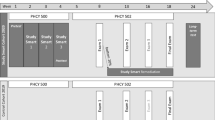Abstract
Third-year clerkships, organized around clinical experiences, may provide students with an uneven or narrowly focused fund of clinical knowledge. This paper describes the results of a comparative trial in which a structured curriculum, based on learning objectives, was introduced into an internal medicine clerkship at one of three teaching hospitals of a single medical school; the other two hospitals, providing similar patient care experiences, were used for comparison purposes. Students who did their clerkship at the hospital using the structured curriculum scored significantly higher on the Medicine section of the National Board Part II examination when scores were adjusted for past academic performance. The structured curriculum was very well received and, according to student perceptions, achieved the goal of expanding their basic clinical knowledge beyond that derived from reading only in connection with patient care. These results support the use of curricular guidelines and objectives as a means of enhancing students’ cognitive experience during clinical clerkships.
Similar content being viewed by others
References
Foley RP, Smilansky J. Teaching techniques: a handbook for health professionals. New York: McGraw-Hill, 1980:1–14
Wigton RS. Effect of lectures and increased experience in gastroen-terology on examination scores of internal medicine residents. Gastroenterology 1981;80:601–4
Gjerde CL. The domains and cognitive processes in medical school objectives. J Med Educ 1978;53:352–5
Mager RF. Preparing instructional objectives. Belmont, California: Fearson Pitman, Inc., 1975:1–122
Christensen CR. Teaching by the case method. Boston, Massachusetts: Harvard Business School, 1981
Wilkins RW, Levinsky NG. Medicine: essentials of clinical practice. 3rd edition. Boston, Massachusetts: Little Brown and Co., 1983
Barrows HS, Tamblyn RM. Problem-based learning: an approach to medical education. New York: Springer Publishing Co. Inc., 1980
Hyman RT. Improving discussion leadership. New York: Teachers College Press, 1980
Kasulis TP, Questioning. In: Gullette MM (ed.). The art and craft of teaching. Cambridge, Massachusetts: Harvard-Danforth Center for Teaching and Learning, 1980;38–48
SAS Institute Inc: SAS user guide: Statistics, 1982 Ed. Carey, North Carolina: SAS Institute Inc., 1982;177
Elstein AS, Schulman LS, Sprafka SA. Medical problem solving: an analysis of clinical reasoning. Cambridge, Massachusetts: Harvard University Press, 1978;292
Tosteson DC. Learning medicine. N Engl J Med, 301:690–4, 1979
Author information
Authors and Affiliations
Additional information
Received from Evans Memorial Department of Clinical Research and Department of Medicine, Section of General Internal Medicine, University Hospital, and Boston University School of Public Health, Boston University Medical Center, Boston, Massachusetts.
Rights and permissions
About this article
Cite this article
Ende, J., Pozen, J.T. & Levinsky, N.G. Enhancing learning during a clinical clerkship. J Gen Intern Med 1, 232–237 (1986). https://doi.org/10.1007/BF02596189
Issue Date:
DOI: https://doi.org/10.1007/BF02596189




